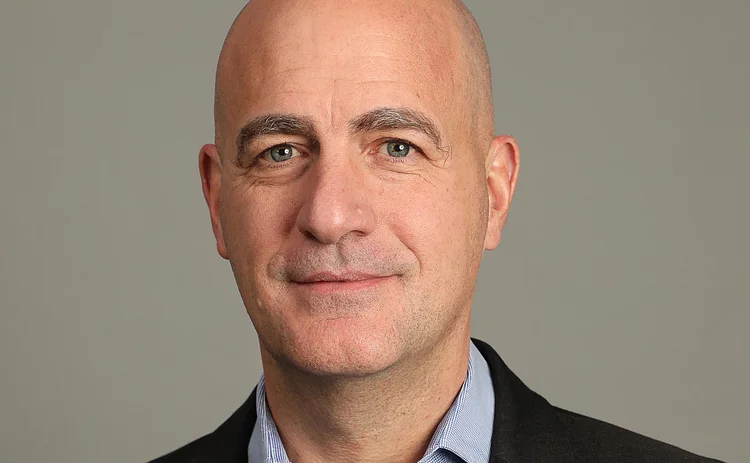
Derivatives house of the year: JP Morgan
Risk Awards 2024: Response to regional banking crisis went far beyond First Republic

When Risk.net spoke to JP Morgan’s global head of rates trading Gil Holmes in mid-October, US Treasury yields were surging again.
Only seven months earlier, an interest rate shock had brought down Silicon Valley Bank (SVB) and two other regional lenders, rattling global markets. But Holmes was relaxed as the benchmark 10-year yield neared 5% – a level not seen in 16 years.
“I do feel pretty good in the sense that, with rates moving even higher in the last several weeks than they were during the SVB crisis, there have been fewer signs of stress from a lot of the regional banks,” he says, with just a hint of satisfaction.
The relative calm was partly due to interest rate hedges JP Morgan executed with regional banks in the frantic days and weeks that followed SVB’s sudden failure on Friday, March 10.
While JP Morgan’s role as a white knight for First Republic is well-documented, far less has been written about the support it provided to other regional lenders caught up in the crisis.
I do feel pretty good in the sense that, with rates moving even higher in the last several weeks than they were during the SVB crisis, there have been fewer signs of stress from a lot of the regional banks
Gil Holmes
Client sensitivities and confidentiality strictures have prevented the bank from speaking publicly about the full extent of its involvement. Senior figures at JP Morgan, including the co-head of markets and securities services Marc Badrichani and more than a dozen of his top lieutenants – shared more details with Risk.net in a series of interviews conducted in October and early November. They describe an all-hands-on-deck effort to contain the crisis and support affected clients that spanned almost every part of the organisation, from retail and investment banking to the markets division.
JP Morgan is no novice when it comes to bank rescues, having honed its skills during the 2008 global financial crisis. But this year’s stress seemed to hit closer to home and drew an immediate response. “You’re talking about regional banks in the US,” says Badrichani. “We’re a US bank. These are our clients. We cover them, we bank them. We’re the first people that are expected to step in. There was no hesitation. The only question was, what can we do to help?”
While the bank’s top management, including chief executive Jamie Dimon and chief operating officer Daniel Pinto, worked with regulators and government officials to craft a rescue package for First Republic, the markets division initially focused on preventing the contagion from spreading.
That started with billions of dollars in repo lifelines, arranged for regional banks over the weekend of March 11, before the Fed stepped in with an emergency funding facility on the Monday. Then, as liquidity concerns began to ease, JP Morgan’s rates desk executed a series of hedges to stem the bleeding in regional banks’ bond portfolios.
In a previously unreported transaction, JP Morgan acquired a multi-billion-dollar portfolio of revolving credit facilities from a regional bank that desperately needed to raise cash. The credit risk of the portfolio was immediately transferred to a private investor in a landmark synthetic securitisation that has since become a template for the industry.
“That deal probably enabled one less bank to fail,” says a market source familiar with the transaction.
The collapse of SVB also rattled US Treasury markets. Yields tumbled and volatility spiked to levels not seen since 2008. While some banks pulled back from the market, JP Morgan traded more US Treasuries by volume on the main client platforms, Bloomberg and Tradeweb, than any other dealer in March, with response rates above 93% on both venues.
As the week drew to a close, the entire bank was in crisis response mode. The turmoil had already spread to Europe, with credit default swap (CDS) spreads on Credit Suisse widening to 3,280 basis points on Friday from 240bp at the start of the month, signalling an imminent collapse. That weekend, Badrichani called a top report in Europe to ensure they were ready for a possible failure on the Sunday.
That person was already in the office: “We’ve been here since 8am,” was the reply.
JP Morgan ended the month with a 35% market share in Credit Suisse’s single-name CDSs.
Riding to the rescue
While markets were volatile at the start of the year, the regional banking crisis caught most in the industry by surprise – JP Morgan included.
Badrichani realised something was awry when the co-head of the investment banking group that advises financial institutions asked to borrow a team from the markets division to assist with a deal. “We knew there was some tension in the system,” he says, “but we didn’t know exactly where”.
The source of the stress soon became clear. SVB was closed by federal regulators on March 10 after an emergency capital raise led by Goldman Sachs fell apart the previous day.
JP Morgan’s investment bank, which was advising First Republic, called in reinforcements. That set off a frantic weekend effort to contain the crisis. The fixed income financing team – which sits within markets and reports to Pranav Thakur, head of global macro markets – worked with the Fed to shore up First Republic’s finances, giving it access to more than $70 billion of additional liquidity.
JP Morgan is reported to have committed as much as $10 billion to the overall package. The bank declined to confirm the exact figure, citing confidentiality agreements with the federal regulators.
We’re a US bank. These are our clients. We cover them, we bank them. We’re the first people that are expected to step in. There was no hesitation. The only question was, what can we do to help?
Marc Badrichani
Billions more in repo lines were doled out to dozens of other regional lenders that were seeing outflows but wanted to avoid signalling weakness by using the Fed’s discount window. Some of these accounts had never traded repos or derivatives with JP Morgan before, and had to sign documentation over the weekend – terms were agreed in rapidly scheduled video calls with legal, counterparty credit and market risk teams. “Everybody was on the line trying to make the right decisions together,” says one person involved in the transactions.
The Fed stepped in on Monday, March 12 with its Bank Term Funding Facility Program, allowing regional banks to obtain immediate liquidity by pledging US Treasuries and agency mortgage bonds in their securities portfolios at par value. That gave regional banks a steady source of funds to meet outflows and shifted attention to the asset side of their balance sheets.
That Monday, the rates desk began receiving calls from anxious regional banks belatedly looking to hedge their securities portfolios. “We had several conversations with regional lenders that wanted us to analyse their balance sheets,” says Holmes. “A lot of them were in the same camp where a mismatch in terms of deposits versus assets – and what was held-to-maturity versus available-for-sale [AFS] – was creating an immense amount of mark-to-market risk.”
One particular bank had a large portfolio of long-dated US Treasuries and agency mortgage securities, which at JP Morgan are traded by different teams. The rates business handles government bonds, while mortgages sit within the securitised products group.
Having the connectivity between rates, mortgages and even banking means we can give the client a full picture
Gil Holmes
The teams worked together to value the portfolio and ran through various stress scenarios to come up with an optimal hedging strategy. “It took several days, but we did a bunch of shocks on those specific bonds and went back to the client with hedging recommendations based on their payout profile and asset/liability mix. And then we actually executed a number of hedges with that counterparty over the course of several days,” says Holmes.
In this case, the hedges involved a flurry of large swaps and swaptions, executed in the depths of the crisis. That exercise was repeated with other banks in the weeks that followed, resulting in the implementation of hedging programmes worth billions of dollars throughout the rest of the year - with clients that in some cases had never hedged with JP Morgan before.
“We had a few of those instances where we carefully accelerated the documentation process to get clients signed up, onboarded and ready to book the trades on their side,” says Holmes.
Many of the regional banks that turned to JP Morgan’s rates desk for the first time during the crisis have now become valued clients.
“We now have relationships with more regional banks than we did before,” says Holmes. “A lot of these banks didn’t have a focus on hedging their portfolios before and some of them didn’t even have docs with us. Now, they’re a lot more attuned to interest rate risk and they’ve become more active hedgers.”
The rates business has seen a surge in hedging activity from regional banks since March, though in many cases the relationships extend well beyond trading. JP Morgan’s investment bankers have continued to advise regional banks on everything from capital raises and balance sheet optimisation to potential mergers and acquisitions. “And as the bankers are doing that, they’re coming to us and saying, ‘What kind of hedges does a bank like this need to reduce mark-to-market drawdowns in the AFS book?’” says Holmes. “Having the connectivity between rates, mortgages and even banking means we can give the client a full picture.”
When Banc of California and PacWest merged in July, JP Morgan agreed to buy almost $2 billion of mortgages from PacWest and arranged hedges for the remainder of its $7 billion loan book to help close the deal. The merger also included a $400 million capital injection from private equity groups Warburg Pincus and Centerbridge Partners, with JP Morgan acting as the sole placement agent for the investment.
More recently, the discussions with regional banks have expanded to include the use of structured financing to lower funding costs and the issuance of debt to meet looming bail-in requirements.
“We’re involved in several conversations where we are trying to find more long-term solutions for some of the financing needs of regional banks,” says Holmes. “Now that they have de-risked and built up cash buffers, the next step is figuring out what to do about long-term funding and incoming regulations.”
Credit where it’s due
JP Morgan’s rescue efforts during the regional banking crisis extended well beyond the rates and financing businesses. The week after SVB failed, JP Morgan’s equities units began working on what many involved see as one of the landmark deals of the year.
Several US regional banks had built up large portfolios of revolving credit facilities to private equity funds, known as sub-lines. As their balance sheets came under pressure, bankers at JP Morgan quickly realised some of these portfolios would have to find new homes.
“We had a sense of which balance sheets were likely to be challenged and we automatically reached out,” says Jason Sippel, global head of equities, credit, public finance and credit portfolio group lending at JP Morgan.
Word soon came back that a regional bank caught in the crosshairs of the crisis was seeking bidders for a multi-billion dollar portfolio of sub-lines. The equities team, which manages JP Morgan’s existing portfolio of private equity revolvers, began preparing a bid.
At the same time, the credit business found a private investor to take the first loss on the portfolio via a synthetic securitisation. The credit risk transfer – thought to be the first involving sub-lines – made the deal far more attractive for JP Morgan from a capital perspective. The savings were shared with the regional bank, which was able to unlock much-needed liquidity at a lower cost than if it had to resort to senior secured funding.
We had a sense of which balance sheets were likely to be challenged and we automatically reached out
Jason Sippel
The entire transaction – from the first call with the regional bank to the sale of the synthetic securitisation to the private investor – was completed in about four weeks.
“We were able to really mobilise our organisation to get this transaction done in a very, very short period of time,” says Rui Fernandes, global head of equities and credit structuring. “This was all happening very quickly when the stress was acute.”
Fernandes is also co-head of JP Morgan's global investor structuring team, which handles synthetic risk transfer (SRT) transactions.
The securitisation proved to be the most complex part of the transaction. The market for such deals had been frozen for several months due to conflicting guidance from US banking regulators. JP Morgan was able to find a structure that worked, even in the most exigent of circumstances.
Fernandes puts this down to “the culture of innovation and optimisation we have around our balance sheet, capital and funding”.
“This was not a prerequisite for us to have done the trade – we would have done it anyway – but the fact we did it without compromising our capital position meant we could deploy incrementally more balance sheet into these types of financing activities,” he adds.
JP Morgan has done just that. By the fourth quarter, its sub-line book had doubled in size. That wasn’t in Sippel’s plans when the year began. “That business was always viewed as somewhat sleepy, tightly priced,” he says. “It wasn’t something where we felt there was a huge amount of alpha.”
But when regional banks began pulling back from lending, especially to private equity and venture capital firms, pricing improved and the velocity of transactions increased. At the same time, JP Morgan’s reach into the private equity and venture capital communities expanded dramatically after it acquired First Republic and picked up clients from SVB.

While that made sub-line lending more attractive on a standalone basis, Sippel notes the “force multiplier” effect it has had on other parts of the firm, including the private and investment bank. “Providing financing to those clients organically creates connections with the underlying private equity partners,” he says. “Those GPs may then hear from us, saying, ‘Here are some other things we’d like you to consider doing with us’. Those are interactions that didn’t happen before.”
More importantly, the securitisation deal that accompanied the purchase of the sub-line portfolio during the crisis re-opened the market for SRTs, with JP Morgan’s global investor structuring team playing a lead role.
Since around 2020, US regulators have maintained that SRTs must include either a financial guarantee or a credit default swap (CDS) to qualify for capital relief. This effectively prevented banks from directly issuing credit-linked notes (CLNs) to investors – a common practice in Europe.
JP Morgan’s solution was to document the transaction in a manner consistent with a derivative agreement. Sippel calls it “a test case” for industrialising credit risk transfers in the US.
Even I’ve been surprised by how much interest we’ve had [in SRTs], with clients that previously were not involved in this space now pushing hard for allocations
Jason Sippel
The deal passed the test. On September 28, the Fed released a short FAQ effectively endorsing JP Morgan’s approach. The following day, regulators wrote to at least six banks confirming that direct CLN structures would qualify for capital relief, subject to certain conditions.
That opened the floodgates. “It’s a juggernaut,” Sippel says of the demand for SRTs. “Even I’ve been surprised by how much interest we’ve had, with clients that previously were not involved in this space now pushing hard for allocations.”
JP Morgan has already executed a second large SRT transaction, with a third in the works. The regional banking crisis and the final Basel III rules issued by the Fed in July have underscored the need for “a more frictionless and sophisticated movement and reallocation of balance sheet for all banks”, says Sippel.
This coming wave of SRT transactions and changes in areas like private credit could result in hundreds of billions of dollars in assets being rehoused both within the banking system and outside it. “I think that market will just grow and grow,” says Sippel. JP Morgan could deploy its fortress balance sheet to hold more of the credit risk originated by other lenders. “In other cases, [private fund] sponsors will hold it. The toolkits are becoming more sophisticated, the velocities are increasing, and more of these deals are going to be happening in the market,” he says.
The bank with a ‘superpower’
Part of what makes JP Morgan unique among large banks is that it seems built for times of crises – perhaps as much out of necessity as choice.
When markets are in turmoil, “the regulators will look to us”, says Badrichani, “and ask, ‘okay, what is JP Morgan doing to help the system?'”
But being expected to help and actually doing it are two different things. He gives three reasons why he thinks JP Morgan so often excels in periods of stress.
The first is sheer scale: “In situations like that, it’s clear that being able to do multiple billions is a huge advantage compared to somebody else who can do one or two, or who needs to syndicate.”
Second is the long-standing relationships it has with core clients. “We don’t just do a single trade with these regional banks. It’s not like they’re calling us for the first time. There is already an element of trust between us,” says Badrichani. “That is the piece that is very hard to compete with, because you don’t do this overnight. That level of trust takes time to build.”
The third and perhaps most crucial reason relates to the bank’s culture and incentive structure, which encourages co-operation rather than competition among employees.
This was especially apparent in March, when different divisions at the bank – and teams within divisions – pulled together to support clients.
All the feedback I’ve gotten from that time is that we were able to handle complexity – cross-product complexity – in a very rapid way and at the right price
Jason Sippel
This starts at the top. “There is a level of trust and understanding between all of us,” says Badrichani. “In a situation like this, if our banking group calls and says, ‘We need resources’, I say, ‘How many do you need?’. And if they tell me five, I’m not arguing that they only need two.”
Co-operation across markets teams was crucial to completing the purchase and securitisation of the sub-line portfolio during the crisis. Last year, JP Morgan combined its equities and credit units under Sippel. At some banks, that would be a recipe for infighting and intrigue. But when the situation called for it, the two teams worked together seamlessly.
Sippel puts this down to the bank’s culture. “For a large organisation, this is a place where it is remarkably easy to reach across aisles,” he says. “We have our downsides, but I would say this is our superpower – the ability to interoperate across products, geographies and functions in a frictionless way.”
When the opportunity first presented itself, equities quickly brought credit into the fold and then drafted in their respective sales and structuring teams. “That meant we were fast. We were able to provide a solution very quickly in terms of pricing complex portfolios and finding other partners to recycle the risk,” says Sippel. “All the feedback I’ve gotten from that time is that we were able to handle complexity – cross-product complexity – in a very rapid way and at the right price. And obviously, we were prepared to deploy very material balance sheet to do that.”
Only users who have a paid subscription or are part of a corporate subscription are able to print or copy content.
To access these options, along with all other subscription benefits, please contact info@risk.net or view our subscription options here: http://subscriptions.risk.net/subscribe
You are currently unable to print this content. Please contact info@risk.net to find out more.
You are currently unable to copy this content. Please contact info@risk.net to find out more.
Copyright Infopro Digital Limited. All rights reserved.
You may share this content using our article tools. Printing this content is for the sole use of the Authorised User (named subscriber), as outlined in our terms and conditions - https://www.infopro-insight.com/terms-conditions/insight-subscriptions/
If you would like to purchase additional rights please email info@risk.net
Copyright Infopro Digital Limited. All rights reserved.
You may share this content using our article tools. Copying this content is for the sole use of the Authorised User (named subscriber), as outlined in our terms and conditions - https://www.infopro-insight.com/terms-conditions/insight-subscriptions/
If you would like to purchase additional rights please email info@risk.net
More on Awards
Joining the dots: banks leverage tech advancements for the future of regulatory reporting
The continued evolution of regulatory frameworks is creating mounting challenges for capital markets firms in achieving comprehensive and cost-effectiveawa compliance reporting. Regnology discusses how firms are starting to use a synthesis of emerging…
Markets Technology Awards 2024 winners' review
Vendors spy opportunity in demystifying and democratising – opening up markets and methods to new users
Risk Awards 2024: The winners
JP Morgan wins derivatives house, lifetime award for El Karoui, Barclays wins rates
Best product for capital markets: Murex
Asia Risk Awards 2023
Technology vendor of the year: Murex
Asia Risk Awards 2023
Best structured products support system: Murex
Asia Risk Awards 2023
Energy Risk Asia Awards 2023: the winners
Winning firms demonstrate resiliency and robust risk management amid testing times
Asia Risk Awards 2023: The winners
All the winners of this year's Asia Risk and Technology awards









